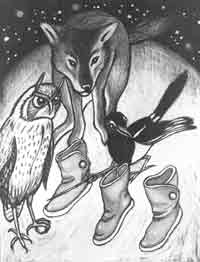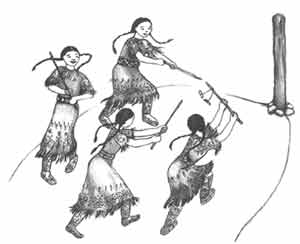 |
||||||||||
 |
||||||||||
 |
||||||||||
 |
||||||||||
|
Search
|
||||||||||
|
Titles |
||||||||||
|
|
||||||||||
 |
|||||||
|
Table of Contents Ball Games and Team Sports Ball Games Bowl Games and Other Games of Chance Games of Chance Games of Skill Hoop Games Awareness Games Awareness Games back to Native American Games and Stories Excerpt Kesitce: The Moccasin Game (Dineh [Navajo] T "Let us play a game of kesitce to decide," someone said. Everyone agreed it was a good idea. A fire was lit and the teams sat on opposite sides. They flipped a piece of wood that was dark on one side and light on the other to see which team would go first. It fell with the dark side up and so the animals of the night were the first to hide the stone. The moccasins were placed side by side in the sand. The night creatures lifted up the blanket so that the day creatures could not see where they hid the stone and they sang the same song that the Dine people sing to this day when they play kesitce. Owl was the one who was hiding the stone, for he was one of the best at the game. While the two sides played, Coyote stood in the middle between them. As long as the night creatures were winning, Coyote said he was on their side. "Ah-ha," Coyote said, "we who are creatures of the night are doing well." The night creatures won again and again. Then Wind, who wanted to help the day creatures, came and whispered in the ear of Magpie. "Owl is cheating. He is keeping the stone in his claws." So, when it was Magpie's turn to take the stick and tap the moccasin where the stone was hidden, Magpie struck Owl's claws instead. Owl dropped the stone. Now it was the turn of the day creatures to hide the stone and they began to win. "This is good," Coyote said. "We who are the creatures of the day are now winning!" Coyote, though, did not fool anyone. That is why, to this day, neither the creatures of the day nor the creatures of the night trust Coyote. The game went back and forth between the two sides. Neither one seemed able to win it all. The two sides were even in the number of counters each had won. Then Wind came and whispered again to Magpie. "Sing the Dawn Song," Wind whispered . "Qua-yei-ka, Qua-yei-ka!" Magpie sang. "Dawn is here, Dawn is here!" As soon as he sang those words, the light of dawn appeared. With the light of the new day, the game had to end. All the animals and birds quickly went back to their homes. So it is, to this day, that day and night are of equal lengths, for the two sides never again came together to finish their game.
Doubleball Except for the Pacific and Northwest coastal areas, doubleball was usually played by women. Girl teams were highly valued in Native culture.
In many places doubleball was a game played by the women and girls, while lacrosse was played by the men and boys. Both lacrosse and doubleball require teamwork, strategy, good hand and eye coordination, balance, and the endurance to run back and forth on a large playing field. Both games emphasize the inclusion of everyone in the game—not just the strongest or most skillful players. Like lacrosse, doubleball is set up with a goal at either end of the field of play. The field may be of almost any size. Teams may also be of any size, but should be equal. In the old days, lacrosse and doubleball games were sometimes played with one goal in one village and the other goal in the next village. Generally, you will want to set up a field at least fifty feet wide and one hundred feet long. Each player in the game is equipped with a stick about an arm's length with a slight curve on one end. Each player uses either one or two sticks. Our version uses a single stick per player. When playing the game, teammates must work together to carry and pass the doubleball, two balls contained in leather, toward their opponents' goal. In order to score, a player must hit or throw the doubleball against the opposing goal, a large pole. In a variant form using a horizontal goal, the doubleball must land balanced on the goal stick. Doubleball is a fast-paced game. Teams must be able to advance quickly toward the other goal while being just as quick to defend their own goal when the ball changes hands. Suggested Rules
Equipment It is strongly suggested that players wear some sort of eye protection. Padded gloves and safety helmets (such as those worn in lacrosse, or bicycle helmets) can add extra safety. back to Native American Games and Stories Reviews “This slender book is packed with information about how to play authentic Native American games, including instructions on making some of the necessary equipment and related stories. The authors also describe the history and skill development underlying the games, offering readers a well-rounded understanding and context for the information. The games are relatively simple and could easily be worked into a curriculum along with the stories As might be expected, the authors document their sources, and the bibliography provides a few more resources for those who wish to delve further. Akweks’ b/w illustrations are peppered throughout the book and are not only decorative but useful when illustrating equipment or the game itself. This is an invaluable resource for any school or public library, and multiple copies are recommended.” —Donna L. Scanlon, Children’s Librarian
“Based on the philosophy that one can learn while one plays, this book combines Native American stories with instructions on how to play authentic games. It begins with a short history of Native American team sports and explains their philosophy that games are a team effort and that everyone should have an opportunity to play to the best of their ability. These games were relied upon for teaching team members to cooperate with each other, as well as for strengthening their minds and bodies. The games themselves are divided into four sections: ball games and team sports, bowl games and other games of chance, games of skill, and awareness games. In each grouping of games, the authors give a brief history of each game, directions on how the game is played, and suggestions for using the games with younger children. The b&w illustrations are well done and clearly depict differing aspects of the games. A bibliography and index are included. This volume would be a great addition to any library that wants to expand its Native American collection and would be useful to both teachers and children. Recommended.” —Renee Troselius, Library/Media Specialist
back to Native American Games and Stories
|
|||||||
|
Fulcrum Publishing – 16100 Table Mountain Parkway, Suite 300 – Golden, Colorado 80403
|
|||||||
 he animals and birds of the day spoke. They said that the sun should shine all the time. The animals and birds of the night spoke. They said that the sun should never rise again. Neither side
could agree with the other.
he animals and birds of the day spoke. They said that the sun should shine all the time. The animals and birds of the night spoke. They said that the sun should never rise again. Neither side
could agree with the other.
